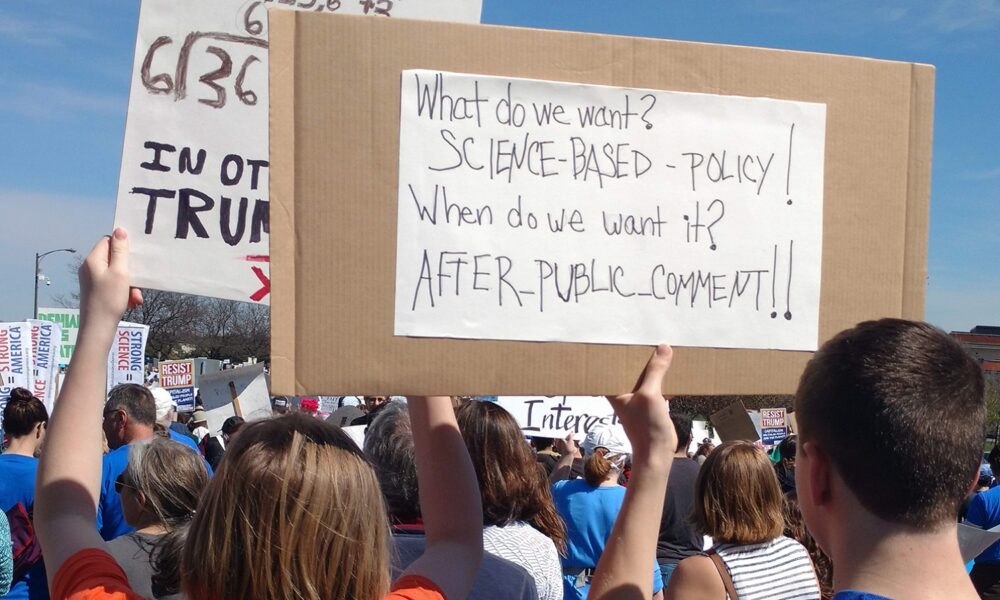When our family participated in the Science March at the Minnesota Capitol in 2017, one of our signs said, “What do we want – Science Based Policy! When do we want it? After Public Comment!” It was not a catchy slogan to write on a cardboard sign, but the message is important to all of our lives. If governments bypass or undermine science and public comments in policy making, our health could be in jeopardy from increased pollution, cases of foodborne illnesses, politically-driven medicine approvals or disapprovals, and more.
The Supreme Court just overturned the doctrine known as “Chevron deference.” This ruling means that judges who might not be engineers or scientists will have more power to overturn rules developed and written by professional agency staff—engineers, scientists, and health professionals—and informed by public comments reflecting lived experiences of those most impacted by these rules. This makes any rules that are intended to provide information about or directly limit pollution to protect our health and the environment more vulnerable to litigation. As a result, this decision will greatly hamper science-based policies and undermine the influence of scientists on federal rules.
It is hard to figure out how exactly federal agencies will respond to this ruling, along with the Corner Post case, as both cases dramatically increase the threat of lawsuits aimed at science-based protections. But it’s likely that rules currently being developed will be altered in some way due to recent Supreme Court decisions. For instance, these rules may be further delayed by agencies to make them better able to withstand legal challenges; they may be tested in court by individuals or companies who seek to dismantle them; or they may be shelved by agencies who may fear that these potential lawsuits will be too resource-intensive on their already strained budgets.
To explore a small piece of what is at stake, let’s take a quick look at some of the rules currently under review at the EPA:
Air emission reporting requirements
If finalized and implemented, this rule will improve the way air pollution emissions are estimated and collected by the EPA. These Air Emission Reporting Requirements describe how, when, which, and how often air pollutant emissions are estimated and reported from polluting facilities. This is a facility’s estimate of what they actually emit, and is used in analyses to compare against their legal limits and to determine if further health protections are needed. Scientists and engineers painstakingly examine emission units, flow rates, and process flow diagrams to determine how pollution reporting should work so that it is consistent, fair, and provides adequate information.
Many people and organizations have commented to shape this rule. Its fate will now be much more vulnerable to the opinions of a lower-court judge or judges ruling on future litigation.
Phasedown of hydrofluorocarbons
There are several rules that inform and facilitate the phasedown of hydrofluorocarbons. Hydrofluorocarbons (HFCs) were developed to replace a type of chemical that impacted the ozone layer in our upper atmosphere, but these replacements are potent greenhouse gases. There are a variety of rules under review that would require tighter controls and also help companies to find safer alternatives.
There is so much information and science backing up the need to phase down these substances, but the Supreme Court’s decision could allow judges to ignore that science and halt the effort to deal with these chemicals.
Reclassification of major pollution sources
This rule is a mouthful—”Review of Final Rule Reclassification of Major Sources as Area Sources Under Section 112 of the Clean Air Act”—but it’s vital: it provides a path for agency experts to review a set of information to determine if a facility emits pollution at low enough levels such that it can be regulated less stringently. Changes in these types of classifications can be really impactful, involving tons and tons of pollutants. When facilities emit less pollution, their regulations require less specific record-keeping and monitoring. This rule requires that when a facility proposes pollution reductions to lessen their applicable regulations (or in environmental regulatory language “moving from being a major source to an area source,”) that the proposed changes are included in the facility’s permit.
How stringently facilities are monitored should be based on science and on the impacts on the people who live nearby—not by a judge’s ideological viewpoint on regulation.
Toxic Substances Control Act updates
There’s a lot going on in the near term with the Toxic Substances Control Act (TSCA) too. If you think of the pollution safeguards as a series of filters, with each rule intended to stop a bit more pollution from harming people, the first stop for hazardous chemicals is TSCA. This is a major federal law that governs if a chemical will be regulated, limited, or even banned.
The EPA is considering several updates to TSCA, including a rule that would make chemical reviews more efficient and eliminating new PFAS from being exempt in TSCA reviews. There are also a variety of new chemicals that are being reviewed under TSCA, including Perchloroethylene (PCE) (a carcinogen and impacts the nervous system), Carbon Tetrachloride (CTC; also a carcinogen and with multiple other health effects), and 1-Bromopropane (1-BP; also a carcinogen and impacts the nervous system).
All of these rules, if litigated, would now be much more vulnerable to the opinion of one judge rather than the diverse and dedicated experts who weighed in on their creation.
Rules impacting per- and polyfluoroalkyl substances (PFAS)
There is a rule in the works that would put effluent limits, guidelines, and standards in place for PFAS using authority under the Clean Water Act, and another adding PFAS as hazardous substances to the Resource Conservation and Recovery Act to inform remediation and cleanup of these substances. PFAS are also known as “forever chemicals”—they do not break down and they are associated with many health problems.
It’s just common sense: we need information about these chemicals; we need them cleaned up where they contaminate the air, water and soil; and we need to phase out future use in favor of safer alternatives.
The fallout from these decisions could endanger our health and environment
The list goes on: EPA is working on rules that provide clarity to existing regulations, making regulation of ballast water discharges more streamlined and efficient, establishing water quality standards in Indian reservations where there are not already standards, and updating the water quality trading program. With any of these rules, a well-funded litigant could find a friendly judge who thinks the underlying laws are too “ambiguous” to allow these rules to stand.
These types of rules go through public comment and are informed by the expertise of community members who are most impacted by the pollution these rules target. The rules are developed by engineers, scientists, health professionals, and professional agency staff who know about environmental protection and how to develop and implement rules. Federal judges have a lot of legal expertise, but their skillset generally doesn’t include this kind of deep knowledge about public health.
The overturning of Chevron deference has the potential to throw all of this work—including the lived experience of communities most impacted—right out the window.

